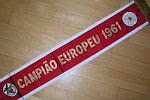Como ja tinha feito um post sobre Paulo Madeira aqui, irei me limitar a falar um pouco sobre a sua carreira na Selecão hoje, tal como o jogo em que foi utilizada esta camisola.
Paulo Madeira teve a sua primeira internacionalização a 28 de Fevreiro 1987, num jogo dos Sub16 contra a Espanha. Foi titular nesse jogo e a seguir desse jogo, seguiram-se mais 11 nos Sub16, onde também conseguiu marcar um golo num jogo contra Israel apenas dois mêses depois da sua estreia.
Aínda em 1987, mas ja com 17 anos de idade, passou para os Sub18 onde também fez exibições sólidas como central, a sua posição de raíz.
A grande surpresa aconteceu em 1989, aínda oficialmente Sub18, quando foi convocado por Carlos Queiroz para representar Portugal no Mundial Sub20 em Riade na Arábia Saudita. Jogou todas 6 partidas até a Final onde se sagrou Campeão Mundial.
Passou a representar Portugal nos Sub21, e fez o seu último jogo como junior a 15 de Outubro 1991, num jogo contra o Luxemburgo. Entretanto ja teve a sua estreia na Seleção A uns mêses mais cedo, a 20 de Fevreiro 1991 contra Malta. Fez um total de 24 jogos como senior, sendo o último contra a Hungria em 1999.
Esta camisola foi utilizada por ele em 1999 no jogo contra o Liechtenstein em Coimbra, onde Portugal venceu por 8:0, a segunda maior goleada de sempre. Antes do encontro Portugal liderava o grupo de qualificação para o Euro 2000 com 15 pontos, um mais que a Roménia. Com mais três jogos para disputar, tudo estava bem encaminhado para a segunda participação num Europeu. Ao fim dos três jogos empatamos dois e vencemos um, o que levou Portugal para segundo lugar. Mas fruto á boa campanha em geral, onde fomos a melhor equipa em segundo lugar, o apuramtento nunca esteve em questão.
As i already made a post about Paulo Madeira here, i will only speak about his carreer at our national team and a bit about the match where he wore this shirt.
He made his debut on 28th of February 1987 in a U16 match vs Spain. He was in the starting line-up and after that he made 11 more matches as a U16. His first goal succeeded only two months after his debut in a match vs Israel. During the year of 1987, but after his 17th birthday he continued to play in in the U18 team where he made solid exibitions that earned him a call to represent Portugal in the 1989 U20 WC. He played in all 6 matches and became World Champion, something that no portuguese team ever had managed before.
From that date on he played U21, as it replaced the U20 in Europe. His last match as a junior was on 15th of October 1991 and he had his first A match already played a few months before. In total he had 24 caps as a senior and 65 in total. His last one was vs Hungary in 1999.
This shirt was used by him in 1999 vs Liechtenstein, where Portugal won 8:0, the second highest victory ever. Before the match Portugal was in the lead of Group 7 of the European Qualifiers for the 2000 Euro. With three more matches after that one, everything seemed on track for the second participation in a Euro tournament. But with only five points out of these matches, we were relegated to second and had to fall back on the best second classified teams rule. But with an excellent goal difference we were best second ranked team and went on to Belgium and The Netherlands.
Jogo/ match: 09.06.1999 Portugal vs Liechtenstein 8:0
Fornecedor/ outfitter: Nike
M
T
G
Y

















